March 25, 2019
President Trump shocked the world on election night, 2016, when he defeated Democratic Party nominee Hillary Clinton by 77 Electoral College votes - 302 to her 207. Clinton’s team held big advantages in the paid media environment. Political advertising insights show Clinton outspending Trump for President by more than $200 million. With Team Hillary holding such a huge advantage on the airwaves, how did Trump for President win?
Rallies Bolster Trump's Advertising Campaign
In a word: rallies. Then-candidate Trump conducted 137 rallies from June 10 - November 7, 2016, in 62 different media markets (DMAs). Each rally earned President Trump tremendous local media coverage in the days surrounding these high profile events. On average, candidate Trump received about 7 minutes per day of local news coverage across the 3-day period that surrounded each rally. What is this coverage worth from a monetary and audience value? President Trump’s rallies garnered the equivalent outreach of what would cost $120 million in local broadcast news coverage, with a staggering 3.8 billion free impressions across the 62 DMAs he visited while campaigning.
So, what political advertising insights does this data provide? To assess this, we treated Trump's rallies as free local media and measured the impact of the rallies by comparing candidate Trump’s vote share in 2016 to candidate Romney’s vote share in 2012. Here are the facts: Of the 62 media markets in which Trump held rallies, nine flipped from DEM to GOP. These markets were:
- Columbus, OH
- Toledo, OH
- Davenport, IA
- Des Moines, IA,
- Erie, PA
- Jackson, MS
- Lacrosse-Eau Claire, WI
- Tallahassee, FL
- Bangor, ME

There are 22 DMA’s in which Trump held rallies that were retained by the Democrats; however, the rallies seemingly impacted Hillary Clinton’s vote share in those markets. On average, Hillary Clinton’s vote share in these markets decreased .09% when compared to President Obama’s in 2012. Here are the five markets where Clinton most underperformed President Obama:
- Cedar Rapids -6.8%
- Cleveland -5.9%
- Portland, ME -5.4%
- Detroit, MI -4.1%
- Lansing -3.5%
There were an additional 33 media markets in which candidate Trump held rallies that were retained by the GOP. What was his impact in those markets? President Trump increased his vote share by 1.7% in these markets when compared to Mitt Romney’s vote share in 2012. Here are the top six media markets where candidate Trump held rallies and outperformed the GOP presidential vote share from 2012:
- Wilkes Barre, Scranton: +10.8%
- Sioux City, Iowa: +10.1%
- Wheeling, WV, Steubenville, OH: +9.0%
- Colorado Springs: +7.7%
- Green Bay: +7.2%
- Johnston Altoona: +6.4%
When you look at these results across all markets where candidate Trump held rallies, you will see that Trump’s vote share increased on average 2.1% while candidate Clinton’s decreased by 2.7%. President Trump’s extensive campaign of rallies across Pennsylvania, Ohio, Michigan, Wisconsin, and Iowa was clearly successful in helping him flip these states and win a substantial Electoral College victory.
 Some people may not be aware that Democratic Party nominee Hillary Clinton did hold 28 total rallies in 18 DMAs in 2016. Her strategy was aggressive - she held four rallies in North Carolina, nine in Florida, and five in Ohio. Unlike Trump; however, she was unable to flip any of the DMAs she visited, and actually lost Des Moines and Toledo despite holding rallies there. Her strategy was influenced by the “Blue Wall” theory; she held rallies to hold onto what she perceived as the most vulnerable states won by President Obama: Florida, Ohio, and Iowa, while looking to pick up North Carolina. This tactic was also reflected in her paid media, where these four states accounted for 64% of her local media expenditures.
Some people may not be aware that Democratic Party nominee Hillary Clinton did hold 28 total rallies in 18 DMAs in 2016. Her strategy was aggressive - she held four rallies in North Carolina, nine in Florida, and five in Ohio. Unlike Trump; however, she was unable to flip any of the DMAs she visited, and actually lost Des Moines and Toledo despite holding rallies there. Her strategy was influenced by the “Blue Wall” theory; she held rallies to hold onto what she perceived as the most vulnerable states won by President Obama: Florida, Ohio, and Iowa, while looking to pick up North Carolina. This tactic was also reflected in her paid media, where these four states accounted for 64% of her local media expenditures.
In 2016, President Trump demonstrated his impressive ability to earn media attention, thereby offsetting his large deficit in paid media expenditures. This ability, perhaps unique to President Trump or other charismatic candidates that can energize voters, has not abated at all; but the President has taken great steps to also bend the establishment to his will. Political advertising insights from 2012 shows that outside groups spent $370 million on behalf of Republican Nominee Mitt Romney, compared to only $76 million for President Trump in 2016. We expect 2020 to more closely resemble 2012 in terms of establishment support for the President. This vastly increased outside assistance, combined with the President’s proven ability to generate earned media attention, will likely make him an even more formidable opponent in 2020 than he was in 2016.






